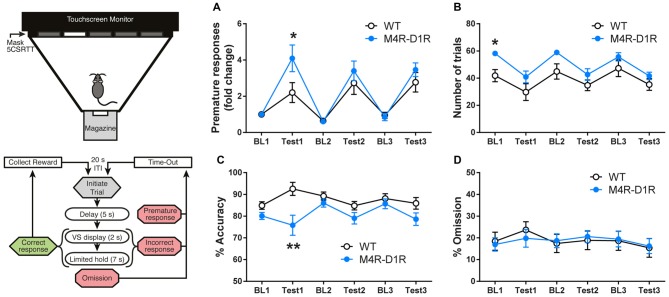Figure 4.
M4R-D1RCre mice exhibit impulsive behavior in the 5-choice-serial-reaction-time-task (5CSRTT). As illustrated in the flow-chart, each trial was initiated by a magazine nose-poke, followed by a 5-s Delay before visual stimulus (VS) display. Touching a window during the Delay was scored as Premature Response (PR) and resulted in Time-out (illumination of the chamber lamp for 5 s) followed by repeat of the same trial. Touches to the window displaying the VS were scored Correct (resulting in Reward), while touches to other windows were scored Incorrect (resulting in Time-out). If the mouse failed to respond during VS display, the trial entered a Limited Hold period, during which Correct or Incorrect touches were still applicable. Failure to respond during this time was scored as an Omission and resulted in Time-out. A 20-s inter-trial interval (ITI) followed each reward collection or Time-out. Summary of performance during the 5CSRTT showing mean values (n = 7 WT, n = 8 M4R-D1RCre) during three sequential baseline (BL) and impulsivity-testing (TEST) conditions. Parameters assessed were trials/session (A), PRs (as fold change from BL1; B), % accuracy (C), and % omissions (D). (A) During BL conditions M4R-D1RCre mice learn the 5CSRTT paradigm better than wildtype littermate control mice, as reflected in a significantly increased number of rewards earned per session. M4R-D1RCre mice showed a significantly increased number of PRs during Test 1 (B). In line with the increase in PRs, M4R-D1RCre mice were also less accurate during Test 1 (C). Omissions did not differ between the two genotypes (D). *p < 0.05, **p < 0.01 two-way ANOVA followed by Bonferroni’s post hoc test.

